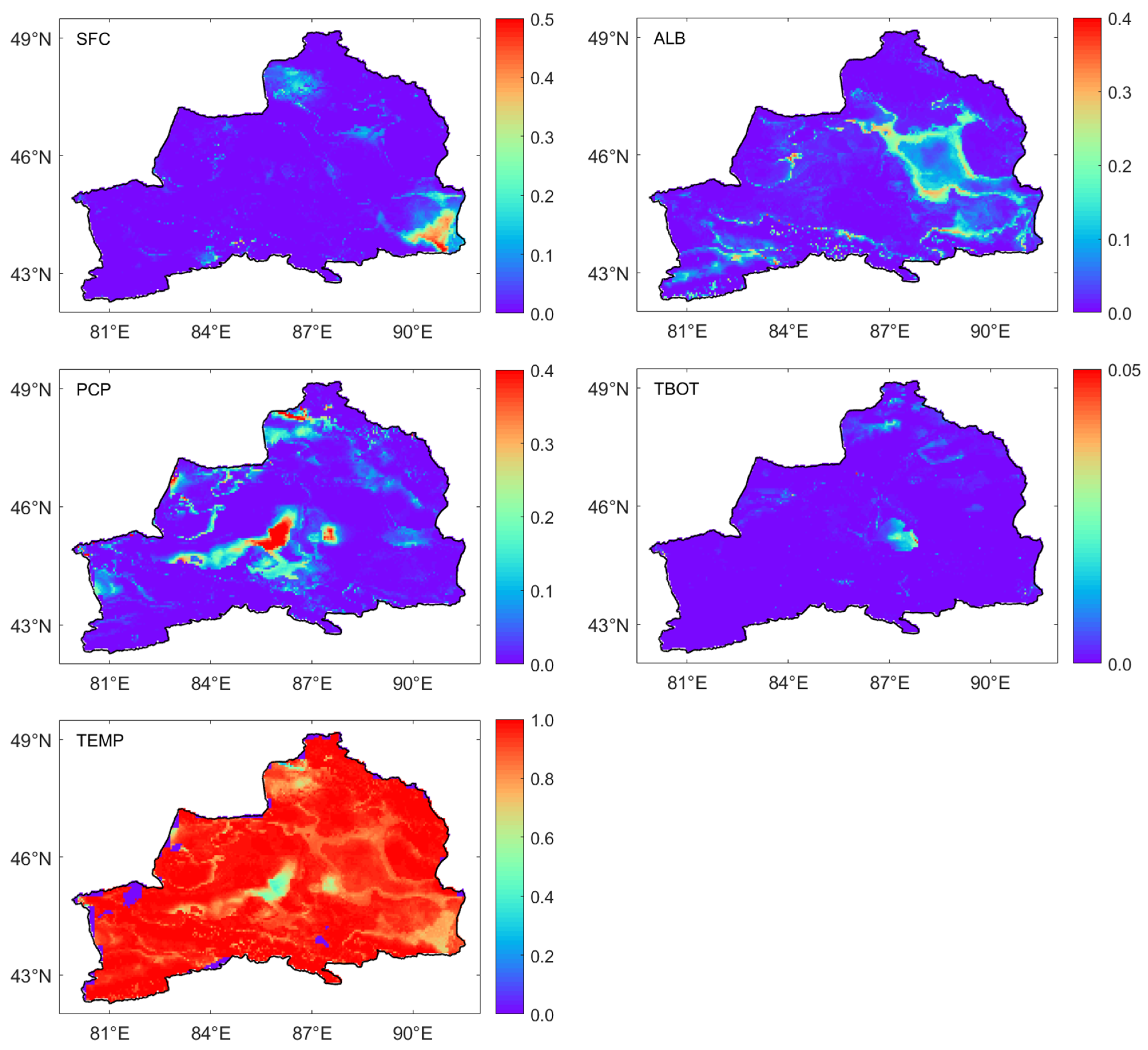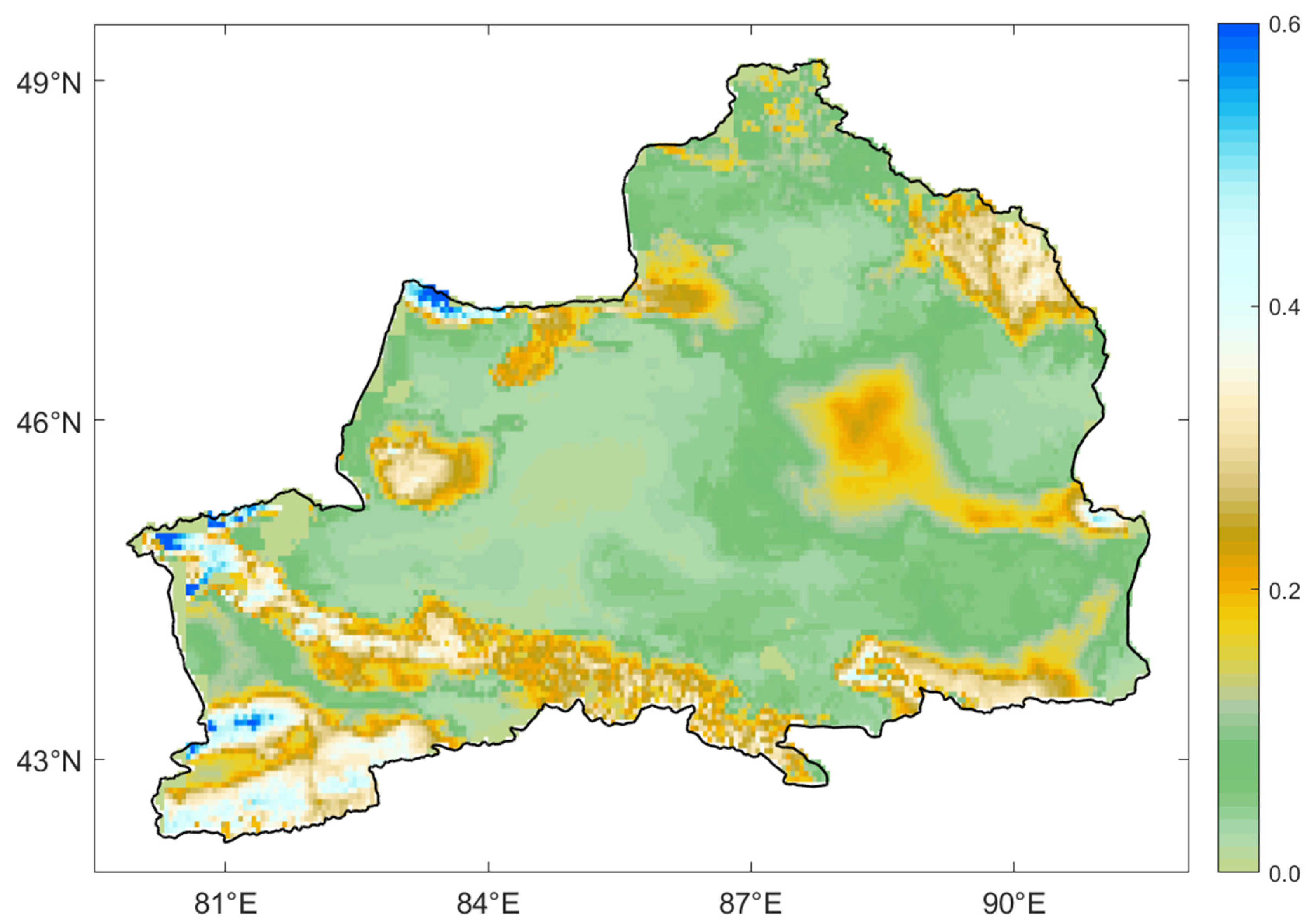Assessing the Sensitivity of Snow Depth Simulations to Land Surface Parameterizations within Noah-MP in Northern Xinjiang, China
Abstract
:1. Introduction
2. Materials and Methods
2.1. Study Area and Data
2.2. Simulation Setups
2.3. Analysis and Evaluation Methods
3. Results and Discussion
3.1. Results of Snow Depth Ensemble Simulations
3.2. Spatial Patterns of the Parameterization Sensitivities
3.3. Uncertainty Analysis of Physical Parameterization Schemes
4. Conclusions
Author Contributions
Funding
Data Availability Statement
Conflicts of Interest
References
- Barnett, T.P.; Adam, J.C.; Lettenmaier, D.P. Potential impacts of a warming climate on water availability in snow-dominated regions. Nature 2005, 438, 303–309. [Google Scholar] [CrossRef]
- Immerzeel, W.W.; Van Beek, L.P.; Bierkens, M.F. Climate change will affect the Asian water towers. Science 2010, 328, 1382–1385. [Google Scholar] [CrossRef]
- Xu, L.; Dirmeyer, P. Snow-atmosphere coupling strength in a global atmospheric model. Geophys. Res. Lett. 2011, 38, L13401. [Google Scholar] [CrossRef]
- Kumar, S.V.; Peters-Lidard, C.D.; Arsenault, K.R.; Getirana, A.; Mocko, D.; Liu, Y.Q. Quantifying the added value of snow cover area observations in passive microwave snow depth data assimilation. J. Hydrometeorol. 2015, 16, 1736–1741. [Google Scholar] [CrossRef]
- Verbunt, M.; Gurtz, J.; Jasper, K.; Lang, H.; Warmerdam, P.; Zappa, M. The hydrological role of snow and glaciers in alpine river basins and their distributed modeling. J. Hydrol. 2003, 282, 36–55. [Google Scholar] [CrossRef]
- Clark, M.P.; Kavetski, D.; Fenicia, F. Pursuing the method of multiple working hypotheses for hydrological modeling. Water Resour. Res. 2011, 47, W09301. [Google Scholar] [CrossRef]
- Clark, M.P.; Hendrikx, J.; Slater, A.G.; Kavetski, D.; Anderson, B.; Cullen, N.J.; Kerr, T.; Hreinsson, E.Ö.; Woods, R.A. Representing spatial variability of snow water equivalent in hydrologic and land-surface models: A review. Water Resour. Res. 2011, 47, W07539. [Google Scholar] [CrossRef]
- Che, T.; Li, X.; Jin, R.; Huang, C.L. Assimilating passive microwave remote sensing data into a land surface model to improve the estimation of snow depth. Remote Sens. Environ. 2014, 143, 54–63. [Google Scholar] [CrossRef]
- Kwon, Y.; Yang, Z.L.; Hoar, T.J.; Toure, A.M. Improving the radiance assimilation performance in estimating snow water storage across snow and land-cover types in North America. J. Hydrometeorol. 2017, 18, 651–668. [Google Scholar] [CrossRef]
- Yang, Z.L.; Niu, G.Y.; Mitchell, K.E.; Chen, F.; Ek, M.B.; Barlage, M.; Longuevergne, L.; Manning, K.; Niyogi, D.; Tewari, M.; et al. The community Noah land surface model with multiparameterization options (Noah-MP): 2. Evaluation over global river basins. J. Geophys. Res. 2011, 116, D12110. [Google Scholar] [CrossRef]
- Huang, C.L.; Margulis, S.A.; Durand, M.T.; Musselman, K.N. Assessment of snow grain-size model and stratigraphy representation impacts on snow radiance assimilation: Forward Modeling Evaluation. IEEE Trans. Geosci. Remote Sens. 2012, 50, 4551–4564. [Google Scholar] [CrossRef]
- You, Y.H.; Huang, C.L.; Hou, J.L.; Zhang, Y.; Wang, Z.; Zhu, G.F. Improving the estimation of snow depth in the Noah-MP model by combining particle filter and Bayesian model averaging. J. Hydrol. 2023, 617, 128877. [Google Scholar] [CrossRef]
- You, Y.H.; Huang, C.L.; Wang, Z.; Hou, J.L.; Zhang, Y.; Xu, P.P. A genetic particle filter scheme for univariate snow cover assimilation into Noah-MP model across snow climates. Hydrol. Earth Syst. Sci. 2023, 27, 2919–2933. [Google Scholar] [CrossRef]
- Gao, J.L.; Huang, X.D.; Ma, X.F.; Feng, Q.S.; Liang, T.G.; Xie, H.J. Snow disaster early warning in pastoral areas of Qinghai province, China. Remote Sens. 2017, 9, 475. [Google Scholar] [CrossRef]
- Zhu, L.L.; Zhang, Y.H.; Wang, J.G.; Tian, W.; Liu, Q.; Ma, G.Y.; Kan, X.; Chu, Y. Downscaling snow depth mapping by fusion of microwave and optical remote-sensing data based on deep learning. Remote Sens. 2021, 13, 584. [Google Scholar] [CrossRef]
- Saha, S.K.; Sujith, K.; Chaudhari, H.S.; Hazra, A. Effects of multilayer snow scheme on the simulation of snow: Offline Noah and coupled with NCEP CFSv2. J. Adv. Model. Earth Syst. 2017, 9, 271–290. [Google Scholar] [CrossRef]
- Moiz, A.; Wei, Z.W.; Naseer, A.; Kawasaki, A.; Acierto, R.A.; Koike, T. Improving snow-process modeling by evaluating reanalysis vertical temperature profiles using a distributed hydrological model. J. Geophys. Res. Atmos. 2022, 127, e2021JD036174. [Google Scholar] [CrossRef]
- Zhang, G.; Chen, F.; Gan, Y.J. Assessing uncertainties in the Noah-MP ensemble simulations of a cropland site during the Tibet Joint International Cooperation program field campaign. J. Geophys. Res. Atmos. 2016, 121, 9576–9596. [Google Scholar] [CrossRef]
- You, Y.H.; Huang, C.L.; Yang, Z.L.; Zhang, Y.; Bai, Y.L.; Gu, J. Assessing Noah-MP parameterization sensitivity and uncertainty interval across snow climates. J. Geophys. Res. Atmos. 2020, 125, e2019JD030417. [Google Scholar] [CrossRef]
- Zheng, H.; Yang, Z.L.; Lin, P.R.; Wei, J.F.; Wu, W.Y.; Li, L.C.; Zhao, L.; Wang, S. On the sensitivity of the precipitation partitioning into evapotranspiration and runoff in land surface parameterizations. Water Resour. Res. 2019, 55, 95–111. [Google Scholar] [CrossRef]
- Niu, G.Y.; Yang, Z.L.; Mitchell, K.E.; Chen, F.; Ek, M.B.; Barlage, M.; Kumar, A.; Manning, K.; Niyogi, D.; Rosero, E.; et al. The community Noah land surface model with multi-parameterization options (Noah-MP): 1. Model description and evaluation with local scale measurements. J. Geophys. Res. 2011, 116, D12109. [Google Scholar] [CrossRef]
- Gan, Y.J.; Liang, X.Z.; Duan, Q.Y.; Chen, F.; Li, J.D.; Zhang, Y. Assessment and reduction of the physical parameterization uncertainty for Noah-MP land surface model. Water Resour. Res. 2019, 55, 5518–5538. [Google Scholar] [CrossRef]
- Chang, M.; Liao, W.H.; Wang, X.M.; Zhang, Q.; Chen, W.H.; Wu, Z.Y.; Hu, Z.C. An optimal ensemble of the Noah-MP land surface model for simulating surface heat fluxes over a typical subtropical forest in South China. Agric. For. Meteorol. 2020, 281, 107815. [Google Scholar] [CrossRef]
- Yang, Q.D.; Dan, L.; Lv, M.Z.; Wu, J.; Li, W.D.; Dong, W.J. Quantitative assessment of the parameterization sensitivity of the Noah-MP land surface model with dynamic vegetation using China FLUX data. Agric. For. Meteorol. 2021, 307, 108542. [Google Scholar] [CrossRef]
- Sobolprime, I.M. Sensitivity analysis for non-linear mathematical models. Math. Model. Comput. Exp. 1993, 1, 407–414. [Google Scholar]
- Dai, H.; Ye, M.; Walker, A.P.; Chen, X.Y. A new process sensitivity index to identify important system processes under process model and parametric uncertainty. Water Resour. Res. 2017, 53, 3476–3490. [Google Scholar] [CrossRef]
- You, Y.H.; Huang, C.L.; Gu, J.; Li, H.Y.; Hao, X.H.; Hou, J.L. Assessing snow simulation performance of typical combination schemes within Noah-MP in northern Xinjiang, China. J. Hydrol. 2020, 581, 124380. [Google Scholar] [CrossRef]
- Xu, J.H.; Shu, H.; Dong, L. DEnKF-Variational Hybrid Snow Cover Fraction Data Assimilation for Improving Snow Simulations with the Common Land Model. Remote Sens. 2014, 6, 10612–10635. [Google Scholar] [CrossRef]
- Huang, X.D.; Liang, T.G.; Zhang, X.T.; Guo, Z.G. Validation of MODIS snow cover products using Landsat and ground measurements during the 2001-2005 snow seasons over northern Xinjiang, China. Int. J. Remote Sens. 2011, 32, 133–152. [Google Scholar] [CrossRef]
- He, J.; Yang, K.; Tang, W.J.; Lu, H.; Qin, J.; Chen, Y.Y.; Li, X. The first high-resolution meteorological forcing dataset for land process studies over China. Sci. Data 2020, 7, 25. [Google Scholar] [CrossRef]
- Chen, Y.; Yang, K.; He, J.; Qin, J.; Shi, J.C.; Du, J.Y.; He, Q. Improving land surface temperature modeling for dry land of China. J. Geophys. Res. 2011, 116, D20104. [Google Scholar] [CrossRef]
- Liston, G.E.; Elder, K. A meteorological distribution system for high-resolution terrestrial modeling (MicroMet). J. Hydrometeorol. 2006, 7, 217–234. [Google Scholar] [CrossRef]
- Ek, M.B.; Mitchell, K.E.; Lin, Y.; Rogers, E.; Grunmann, P.; Koren, V.; Gayno, G.; Tarpley, J.D. Implementation of Noah land surface model advances in the National Centers for Environmental Prediction operational mesoscale Eta model. J. Geophys. Res. Atmos. 2003, 108, 8851. [Google Scholar] [CrossRef]
- Chen, F.; Manning, K.W.; LeMone, M.A.; Trier, S.B.; Alfieri, J.G.; Roberts, R.; Tewari, M.; Niyogi, D.; Horst, T.W.; Oncley, S.P. Description and evaluation of the characteristics of the NCAR high-resolution land data assimilation system. J. Appl. Meteorol. Climatol. 2007, 46, 694–713. [Google Scholar] [CrossRef]
- Cuntz, M.; Mai, J.; Samaniego, L.; Clark, M.; Wulfmeyer, V.; Branch, O.; Attinger, S.; Thober, S. The impact of standard and hard-coded parameters on the hydrologic fluxes in the Noah-MP land surface model. J. Geophys. Res. Atmos. 2016, 121, 10676–10700. [Google Scholar] [CrossRef]
- Chen, F.; Dudhia, J. Coupling an advanced land surface-hydrology model with the Penn State-NCAR MM5 modeling system. Part I: Model implementation and sensitivity. Mon. Weather Rev. 2001, 129, 569–585. [Google Scholar] [CrossRef]
- Cai, X.T.; Yang, Z.L.; Xia, Y.L.; Huang, M.Y.; Wei, H.L.; Leung, L.R.; Ek, M.B. Assessment of simulated water balance from Noah, Noah-MP, CLM, and VIC over CONUS using the NLDAS test bed. J. Geophys. Res. Atmos. 2014, 119, 13751–13770. [Google Scholar] [CrossRef]
- Xia, Y.; Cosgrove, B.A.; Mitchell, K.E.; Peters-Lidard, C.D.; Ek, M.B.; Kumar, S.; Mocko, D.; Wei, H.L. Basin-scale assessment of the land surface energy budget in the National Centers for Environmental Prediction operational and research NLDAS-2 systems. J. Geophys. Res. Atmos. 2016, 121, 196–220. [Google Scholar] [CrossRef]
- Xia, Y.; Ek, M.B.; Wu, Y.; Ford, T.; Quiring, S.M. Comparison of NLDAS-2 simulated and NASMD observed daily soil moisture. Part I: Comparison and analysis. J. Hydrometeorol. 2015, 16, 1962–1980. [Google Scholar] [CrossRef]
- Gao, Y.H.; Li, K.; Chen, F.; Jiang, Y.S.; Lu, C.G. Assessing and improving Noah-MP land model simulations for the central Tibetan Plateau. J. Geophys. Res. Atmos. 2015, 120, 9258–9278. [Google Scholar] [CrossRef]
- Saltelli, A.; Annoni, P.; Azzini, I.; Campolongo, F.; Ratto, M.; Tarantola, S. Variance based sensitivity analysis of model output. Design and estimator for the total sensitivity index. Comput. Phys. Commun. 2010, 181, 259–270. [Google Scholar] [CrossRef]





| Parameterization Description | Scheme Options |
|---|---|
| Dynamic vegetation (DVEG) | 1. off [Default], 2. on |
| Canopy stomatal resistance (CRS) | 1. Ball-berry [Default], 2. Jarvis |
| Soil moisture factor controlling stomatal resistance (BTR) | 1. Noah scheme [Default], 2. CLM scheme, 3. SSiB scheme |
| Runoff and groundwater (RUN) | 1. SIMGM [Default], 2. SIMTOP, 3. Schaake96, 4. BATS |
| Surface layer drag coefficient (SFC) | 1. M-O [Default], 2. Original Noah (Chen97) |
| Frozen soil permeability (INF) | 1. NY06 [Default], 2. Koren99 |
| Super-cooled liquid water in frozen soil (FRZ) | 1. NY06 [Default], 2. Koren99 |
| Radiation transfer (RAD) | 1. gap = F(3D, cosz) [Default], 2. gap = 0, 3. gap = 1 − FVEG |
| Snow surface albedo (ALB) | 1. BATS, 2. CLASS [Default] |
| Partitioning of precipitation into rainfall and snowfall (PCP) | 1. Jordan91 [Default], 2. BATS, 3. Noah |
| Lower boundary condition of soil temperature (TBOT) | 1. Zero-flux scheme, 2. Noah [Default] |
| First snow layer or soil temperature time scheme (TEMP) | 1. Semi-implicit [Default], 2. Fully implicit |
Disclaimer/Publisher’s Note: The statements, opinions and data contained in all publications are solely those of the individual author(s) and contributor(s) and not of MDPI and/or the editor(s). MDPI and/or the editor(s) disclaim responsibility for any injury to people or property resulting from any ideas, methods, instructions or products referred to in the content. |
© 2024 by the authors. Licensee MDPI, Basel, Switzerland. This article is an open access article distributed under the terms and conditions of the Creative Commons Attribution (CC BY) license (https://creativecommons.org/licenses/by/4.0/).
Share and Cite
You, Y.; Huang, C.; Zhang, Y. Assessing the Sensitivity of Snow Depth Simulations to Land Surface Parameterizations within Noah-MP in Northern Xinjiang, China. Remote Sens. 2024, 16, 594. https://doi.org/10.3390/rs16030594
You Y, Huang C, Zhang Y. Assessing the Sensitivity of Snow Depth Simulations to Land Surface Parameterizations within Noah-MP in Northern Xinjiang, China. Remote Sensing. 2024; 16(3):594. https://doi.org/10.3390/rs16030594
Chicago/Turabian StyleYou, Yuanhong, Chunlin Huang, and Yuhao Zhang. 2024. "Assessing the Sensitivity of Snow Depth Simulations to Land Surface Parameterizations within Noah-MP in Northern Xinjiang, China" Remote Sensing 16, no. 3: 594. https://doi.org/10.3390/rs16030594






